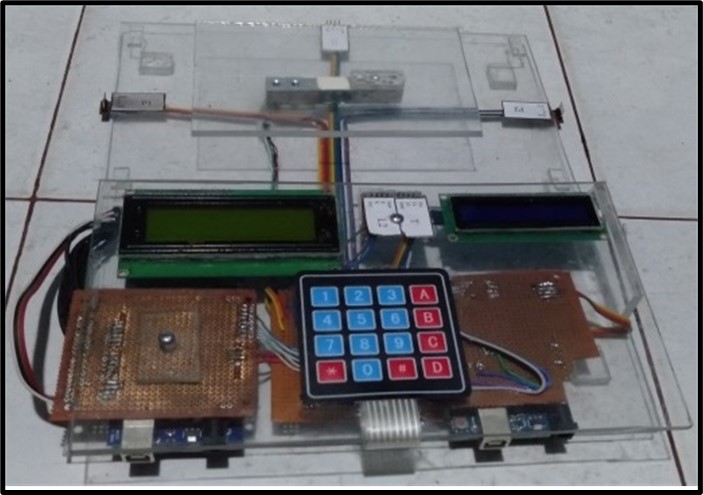Development of Arduino Uno-based real learning media for measuring density of objects
DOI:
https://doi.org/10.12928/jrkpf.v9i1.27Keywords:
ardouno uno, massa jenis, density, development realAbstract
The purpose of developing Arduino Uno-based physics learning media to measure density is to determine the level of feasibility based on the assessment of media experts and material experts, as well as to determine student responses to the development of learning media carried out. This study uses the ADDIE model which consists of 5 stages, namely analysis, design, development, implementation, and evaluation. Based on the data analysis, it can be concluded that the validation of the Arduino Uno-based physics learning media by two media experts obtained an average percentage score of 92.08% with very decent criteria and by two material expert validators obtained an average percentage score of 88, 75% with very decent criteria. Student responses to the Arduino Uno microcontroller-based physics learning media obtained an average percentage score of 84.58% with very decent criteria. The implication of this research is that teachers and students can use tools developed digitally and can compare them with manual experiments.
References
A. Rizal. R. I. Adam. and S. Susilawati. “Pengembangan Laboratorium Virtual Fisika Osilasi.” J. Online Inform.. vol. 3. no. 1. p. 55. 2018. doi: 10.15575/join.v3i1.140.
A. K. Triatmaja and M. Khairudin. “Study on Skill Improvement of Digital Electronics Using Virtual Laboratory with Mobile Virtual Reality.” J. Phys. Conf. Ser.. vol. 1140. no. 1. 2018. doi: 10.1088/1742-6596/1140/1/012021.
H. Prasetyo and W. Sutopo. “Industri 4.0: Telaah Klasifikasi Aspek Dan Arah Perkembangan Riset.” J@ti Undip J. Tek. Ind.. vol. 13. no. 1. p. 17. 2018. doi: 10.14710/jati.13.1.17-26.
S. Pfeiffer. “The Vision of ‘Industrie 4.0’ in the Making—a Case of Future Told. Tamed. and Traded.” Nanoethics. vol. 11. no. 1. pp. 107–121. 2017. doi: 10.1007/s11569-016-0280-3.
C. Straight and M. Materials. “Design Physics Props Based on Arduino Nano Sensors on Irregularly.” vol. 5. no. 1. pp. 26–30. 2021.
W. Indrasari. C. E. Rustana. and Zulfikar. “Development a practicum tools to measure the speed of the air using Arduino Uno Microcontroller.” J. Phys. Conf. Ser.. vol. 1816. no. 1. 2021. doi: 10.1088/1742-6596/1816/1/012109.
A. U. Mentsiev. Z. A. Gerikhanov. and A. R. Isaev. “Automation and IoT for controlling and analysing the growth of crops in agriculture.” J. Phys. Conf. Ser.. vol. 1399. no. 4. 2019. doi: 10.1088/1742-6596/1399/4/044022.
T. P. Otomatis and S. Ultrasonik. “Pengembangan Media Trainer Pintu Otomatis dengan Sensor Ultrasonik . RFID . dan Pir Berbasis Arduino pada Mata Pelajaran Mikroprosessor dan Mikrokontroler Kelas X di SMKN 1 Driyorejo Deva Feggantara Pakshi Jenaro S1 Pendidikan Teknik Elektro . Fakultas Te.” pp. 11–18. 2021.
S. Arikunto. Prosedur Penelitian Suatu Pendekatan Praktik. Jakarta: Rineka Cipta. 2010.
M. Matsun. D. Ramadhani. and I. Lestari. “Pengembangan Bahan Ajar Listrik Magnet Berbasis Android di Program Studi Pendidikan Fisika IKIP PGRI Pontianak.” J. Pendidik. Mat. dan IPA. 2018. doi: 10.26418/jpmipa.v9i1.23703.
M. Matsun. H. Darmawan. and L. Fitriyanti. “Pengembangan Media Pembelajaran Fisika Berbasis Macromedia Flash Topik Bahasan Pesawat Sederhana.” J. Pendidik. Mat. dan IPA. 2019. doi: 10.26418/jpmipa.v10i1.25861.
Y. R. Liana. S. Linuwih. and S. Sulhadi. “Internet of Things Based Learning Media with Problem Solving Approach: Its Effect on Higher Order Thinking Skills.” J. Ilm. Pendidik. Fis. Al-Biruni. vol. 9. no. 2. pp. 225–239. 2020. doi: 10.24042/jipfalbiruni.v9i2.6313.
R. A. Atmoko. R. Riantini. and M. K. Hasin. “IoT real time data acquisition using MQTT protocol.” J. Phys. Conf. Ser.. vol. 853. no. 1. 2017. doi: 10.1088/1742-6596/853/1/012003.
Y. R. Liana. S. Linuwih. and Sulhadi. “Science activity for gifted young scientist: Thermodynamics law experiment media based IoT.” J. Educ. Gift. Young Sci.. vol. 8. no. 2. pp. 757–770. 2020. doi: 10.17478/JEGYS.657429.
M. Idayu et al.. “Pembuatan Set Eksperimen Gerak Vertikal Bawah Berbasis Sensor Ping Dan Sensor Photogate Dengan Tampilan PC.” vol. 12. no. 1. pp. 22–29. 2019.
W. Priharti. A. F. K. Rosmawati. and I. P. D. Wibawa. “IoT based photovoltaic monitoring system application.” J. Phys. Conf. Ser.. vol. 1367. no. 1. 2019. doi: 10.1088/1742-6596/1367/1/012069.
Y. Ma. W. Wu. and Q. He. “Algorithm for Object Detection using Multi-Core Parallel Computation.” Phys. Procedia. vol. 33. pp. 455–461. 2012. doi: 10.1016/j.phpro.2012.05.089.
A. Rizky. A. Pramesti. and H. K. Rustam. “Edukatif : Jurnal Ilmu Pendidikan Peningkatan Prestasi Belajar Siswa dengan Menerapkan Kecerdasan Emosional dan Dukungan Sosial pada Siswa SMA.” vol. 3. no. 4. pp. 1699–1707. 2021.

Downloads
Published
Issue
Section
License
Copyright (c) 2022 Matsun Matsun, Boisandi Boisandi, Ira Nofita Sari , Soka Hadiati , Mikael Trimon Zadrianus

This work is licensed under a Creative Commons Attribution-NonCommercial 4.0 International License.







